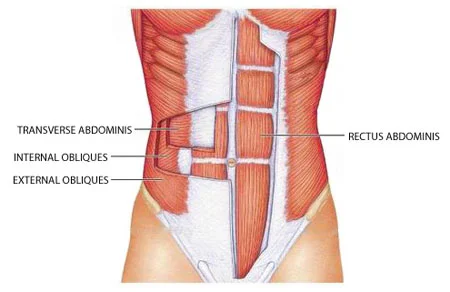Perhaps you are wondering what in the world that mouthful of syllables is? Well you’ve come to the right place! This week’s post is especially important for all pregnant and postpartum women.
What is it?
To understand what this is, we have to go back to anatomy. There are 4 abdominal muscles, 3 of which are symmetrical side to side. The fourth muscle surrounds your internal organs like a corset. These three muscles come together at the mid-line of your body to connect together and provide support for your body and regulate the pressure inside your abdomen.
Diastasis recti abdominis (DRA) is when the connective tissue of the abdominal muscles separates. It happens in about 50% of women during the second trimester of pregnancy, 66-100% of women during the third trimester, and in about 53% of women after they have the baby. These are estimates, although the real numbers may be much higher. This is a completely painless separation - you don’t have a day or moment where you go “ahhh my stomach is tearing!” so many women do not even know they have it.
The pictures below show the progression from normal, to diastasis rectus abdominis, and the resulting "mommy belly" on the far right.
Left = normal, Middle = diastasis recti, Right = "mommy tummy" as a result of DRA postpartum
You are at a greater risk of developing DRA if you are: >33 years old, having multiples, have a large baby, gain >35lbs during pregnancy, or have a c-section. Men can also have DRA due to obesity or any surgery which cuts through the abdominal muscles.
Why does it matter?
Research has shown us that 66% of women with a DRA will also have some pelvic floor dysfunction! That could mean leaking pee/poop/gas, going to the bathroom too frequently, painful sex, pain in the pelvic area, and difficulty pooping.
Having a DRA also results in altered muscle activation. One study found that having a DRA results in a 70% decrease in one of the key stabilizing muscles of your abdomen, called the transverse abdominis (TA). The TA is SUPER important! It works very closely with the back muscles (known as the multifidus), diaphragm, and pelvic floor muscles to provide stability to your body as your move around.
So why does that matter? Well if the correct muscles can't fire when they need to, then other structures in your body are going to have to pick up the slack. If this goes on for years and years, then you may develop breakdown of the tissues which have been overworked.
Now I should remind you that some of these separations are going to rejoin on their own, no problem. But many of them will not. And even a closure of this separation does not guarantee that the right muscles fire when they need to.
Ok so I'm about to get on my "this drives me insane" podium for a little bit. Here's the cycle that gets me all worked up. We know that MANY women are going to develop DRA. But most women a) aren't going to know this is even possible b) might know it's possible but have no idea what to do about it and c) society is pushing all these awesome mommies to "get back to your pre-baby body."
So what's that set us up for? A lot of women getting right back into their exercise routines with a disadvantage... because not only are they lacking good support from the abdominal muscles, but after pregnancy, and especially after a vaginal birth your pelvic floor muscles need some work too. So 2/4 of the muscles of your core aren't working right.
Which is why I want to show you how to screen yourself for DrA!
How to screen yourself for DRA
The best way to diagnose DRA is to use real time ultrasound imaging... but most people (patients OR practitioners) don't have that laying around. Good news, you can still perform a reliable screen just by using your fingers.
Check out the free PDF on how to screen yourself! Better yet, share with your friends and family.
DRA is most common at the belly button, then above the belly button, and is least common below the belly button. You should check yourself starting in the 2nd trimester of pregnancy and again after having the baby. Even if you had a baby years ago, you should check yourself if you haven't before.
It is normal to have between 1-2 fingerwidths of space between the abdominal muscles. If you feel a firm resistance below your fingers and fit 2 or less fingers in that space, then you DO NOT have a diastasis.
DRA should be treated before and definitely after pregnancy. During pregnancy you can monitor the separation and start engaging the right muscles, but the goal is not to close the separation because the baby is still growing!
If you feel like you can push the tissue down towards your spine when your head is curled up then you have a separation which needs to be addressed. If you can fit more than 2 fingers in that space AND it's soft then again, you need treatment.
However many fingers you can fit in the space is the "size" of your diastasis. For example, you may have a 3 finger diastasis above your belly button and a 4 finger diastasis below your belly button.
Another giveaway that you have diastasis is the characteristic “bulge” you may see as you lift your head up. This indicates that you have DRA but does not tell you how large the separation is.
Do you have a separation? Check out this post on treatment!
Resources:
Herman & Wallace, Care of the Pregnant Patient Course, April 30-May 1, 2016.
Therapeutic Exercise Moving Toward Function. 3rd edition. Brody & Hall.













